Acer V7-482PG-9884 Review: Everything You Need
by Jarred Walton on August 24, 2013 12:00 AM ESTAcer V7 Battery Life
So far we’ve looked at CPU and GPU performance metrics, but perhaps more important on any laptop is going to be battery life. Improving power use/battery life was one of Intel’s key goals with Haswell, and so far we’ve seen clear evidence of that in the Haswell laptops that we’ve reviewed. The Acer Aspire V7 confirms that trend, boasting some of the best (normalized) battery life figures that we’ve seen from a Windows laptop.
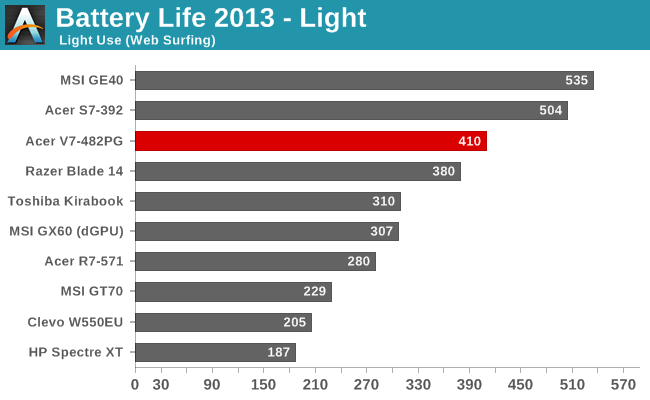
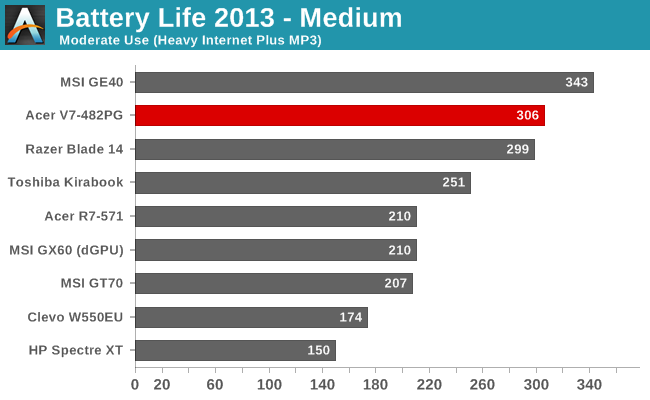
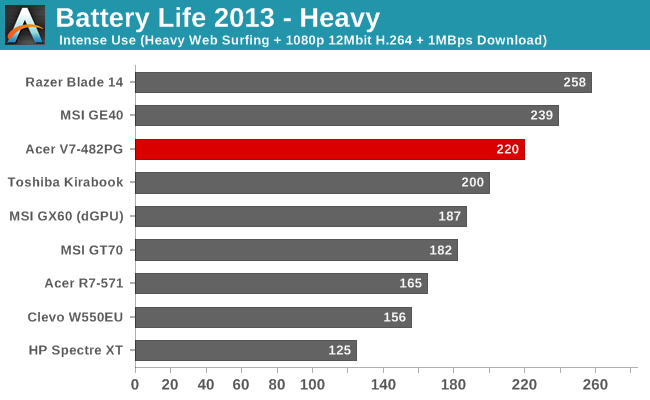
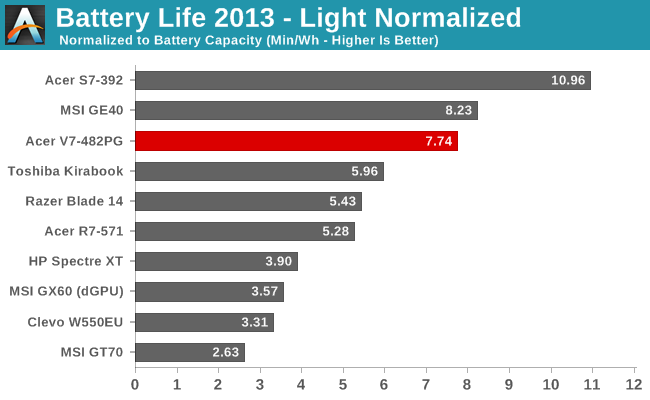
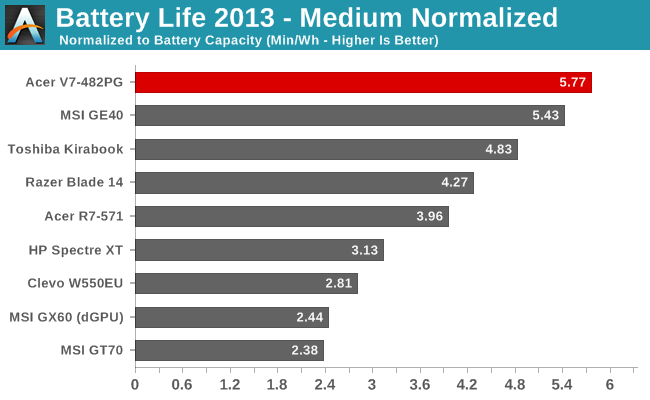
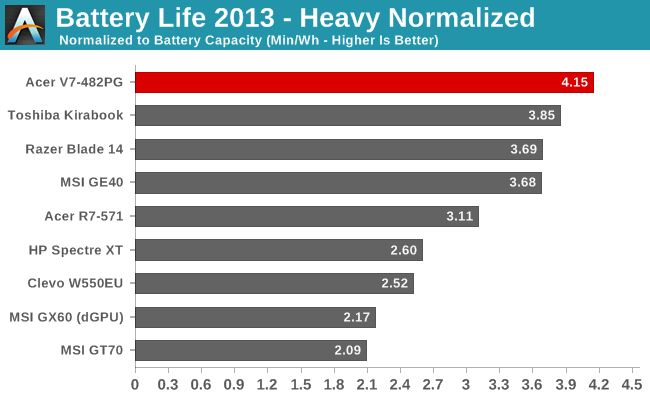
The 53.6 Wh battery isn’t the highest capacity battery you’ll find on market, but it’s the same capacity that Apple uses in the MacBook Air 13 (2013). What’s not the same is the battery life that you get with Windows compared to OS X. With Haswell, the Aspire V7 basically matches what Apple was able to do with the MacBook Air 13 (2012): around seven hours of battery life in our light workload. For reference, the new MBA13 delivered 11 hours in the same test. Still, the Haswell laptops are all posting significant gains over the previous generation Ivy Bridge laptops.
And thanks to NVIDIA’s Optimus Technology, even laptops with discrete GPUs like the MSI GE40 and Acer V7 don’t take a hit to battery life – at least when the GPU isn’t active. Power up the GPU and run a game, on the other hand, and the story changes quite a bit: we measured just 98 minutes of battery life looping 3DMark11 on the Acer V7 (with the GPU set to “prefer maximum performance” in the control panel and using the Balanced power profile). That might seem terrible, and it’s certainly not great, but higher performance GPUs are almost always throttled on battery power, regardless of what settings you use – the MSI GE40 delivered slightly less battery life in our simulated gaming test, with roughly the same performance as the Acer V7 under the same conditions. So basically, on battery power the GT 750M and GTX 760M aren’t all that different, despite the latter having twice as many shaders and substantially more memory bandwidth.
Getting back to the battery life aspect, the V7 posts good results certainly, but I was hoping for even a bit more from our first complete Haswell Ultrabook review. Perhaps the 14” touchscreen is part of the issue, as it could be sucking down precious milliwatts. Other components are also likely a factor, as the Acer S7-392 is quite close to the MBA13. Ultimately, we’re looking at average power draw for the entire laptop of around 7.7W in our Light test on the V7 compared to roughly 4.8W for the MBA13 in the same test under OS X; the S7 Haswell Ultrabook measured 5.4W, which is pretty close to the same sort of gap we’ve seen in the past. As for the V7, coming up with items to account for almost 3W is difficult.
I’m frequently amazed at how much better battery life is with Apple hardware under OS X. We’ve seen in the past that Apple usually optimizes (in a good way) quite heavily in their OS to achieve good battery life, and when you switch to Windows via Boot Camp you lose a lot of battery life. Anand didn’t test Windows battery life with the new MBA13, but I wonder what it’s like, because the usual 30% drop would put it on equal footing with something like the V7. I suspect with Haswell, the opportunities to further tune the OS and hardware for improved battery life are even greater, though, so we might see a 50% drop in battery life with the MBA13 under Windows.
If you need 10+ hours of battery life in Windows, it looks like you’ve got a couple options right now: get a system that’s not as fast (e.g. the V7 has a discrete GPU and hybrid storage with 12GB RAM while the S7 is iGPU only, pure SSD, and 8GB RAM), or find something with a higher capacity battery or a slice battery. For seven hours of useful work – and potentially eight or more if you turn the LCD brightness down a few more notches and don’t constantly surf the Internet – the V7 should be sufficient for most users.










62 Comments
View All Comments
JarredWalton - Saturday, August 24, 2013 - link
Build quality is an unknown, as is battery life and some other factors, but the bigger issue is that you just can't get it yet, at least in the US. I need to ping Gigabyte and see what's up, as the only place I can find it in the US says, "This product is not available and cannot be purchased. It has been discontinued by the manufacturer or vendor." But it might simply be in the pre-release phase.GrammarNietzsche - Saturday, August 24, 2013 - link
The "major flaw" with the P34G seems to be its TN panel. source: http://www.expertreviews.co.uk/laptops/1300168/gig...You can also see the color shift on YouTube videos of the P34G.
davejake - Saturday, August 24, 2013 - link
The Gigabyte specs page claims it to be 1080p AHVA (~IPS)http://www.gigabyte.com/products/product-page.aspx...
This might be another obnoxious case of the various country models being different.
Also, thanks Jarred for the response. The "Gigabyte NB" facebook page keeps talking about early september availability for the p34g-- later for the the p35k-- but I'm trying to not hold my breath.
Samunosuke - Saturday, August 24, 2013 - link
Been looking forward to this review ever since you mentioned it was coming, in your R7 review. I believe this particular SKU is seriously overpriced. The model available on the US ncix website comes with an i5-4200U, GT 750m 4GB,same 1080p IPS touchscreen and 500GB + 24GB storage for $899. To me this is a far better value proposition than the $1300 model. The i5 might be a bottleneck in some games but its not going to be too different from the i7.Comparing this to the Asus N550 and I feel that the N550JV-DB72T is a far better deal with an i7-4700HQ, same GT 750m (2GB), 1080p IPS touchscreen,all aluminum body, max 16GB RAM and 3 USB 3.0 ports. Although the Acer has an msata slot for ssd's, the Asus has an optical drive where the mechanical drive can be put while a 2.5" ssd occupies the main HDD slot. Weight and thickness favour the Acer but I'm willing to accept that. The Acer is $1066 for the touchscreen version and $969 for the matte non touch. Absolute no brainer.
JarredWalton - Saturday, August 24, 2013 - link
The ASUS N550 does weigh about 1.5 pounds more, let's not forget that, and it looks like the same basic design as the N56JV, which was good but still rather bulky, with more plastic in the chassis. If you're after something with higher performance than the V7, there are many options out there; if you want what is basically a gaming Ultrabook that can handle any moderate task you might throw at it, I think the V7-482PG strikes a nice balance. I would like to have the option for a 1080p matte non-touch if it could save $150, but sadly there isn't one.Funny enough, the NCIX version of the V7 is apparently a Canadian model (http://store.acer.com/store/acerna/en_CA/pd/ThemeI... This is one of the frustrating things with Acer, ASUS, and a lot of other OEMs: they have good SKUs that are only released in specific markets, and often I can't figure out why. I've never tried ordering from NCIX before, but for $899 (though it's backordered), the V7-482PG-6662 is basically giving you a slower CPU, smaller HDD and less RAM for $400 less. Of course, that's a "street price" and I suspect the 9884 street prices might end up in the $1100-$1200 range, making it a more reasonable upgrade.
GrammarNietzsche - Saturday, August 24, 2013 - link
The 9884 is available on the US NCIX site as well. I couldn't link it in this comment, so you'll have to remove the (dot)http://us.ncix(dot)com/products/?sku=83180&vpn...
JBaich - Saturday, August 24, 2013 - link
Congrats to Acer for reversing course on the "race to the bottom". RTTBSadly, it might be another 10 years for me before the name Acer doesn't resonate with garbage. They will, and should, suffer for a build-em-and-sell-em-cheap strategy. I'm not convinced.
Anonymous1a - Saturday, August 24, 2013 - link
I was wondering, given that the processor, despite being an i7, is still a ULT processor, and not even a quad-core, will this not be a limiting factor to the graphics card and will this laptop be able to render graphically challenging games?JarredWalton - Saturday, August 24, 2013 - link
The majority of games still don't really need more than one or two CPU cores, and with Turbo Boost you're still able to hit 2.7-3.0GHz on the i7-4500U. With a faster GPU it would be more of a bottleneck, but the GT 750M is clearly tapped out in most titles already, at least at our Mainstream settings. (You'll notice that overclocking the GPU RAM didn't help on the Value settings, but that could be more the GPU core not needing more RAM than a CPU bottleneck; I'd have to investigate more to say for certain.) I think a GTX 765M would probably be where we see the shift to being CPU bound with a ULT processor, but even then you can usually get >40FPS from the CPU if the GPU can manage, so you can turn up details to compensate if you had a faster GPU.This is where the MSI GX60 runs into problems with some games, as single-threaded performance of the A10 APUs is still significantly slower than even the ULV/ULT parts. It's pretty sad that an Ultrabook with a much slower GPU can outperform it in several of the games, even at Mainstream detail.
just2btecky - Saturday, August 24, 2013 - link
Acer Aspire V7-482PG-9884 has a funky name I'll never remember. I aspire:) for a name that's really cute.